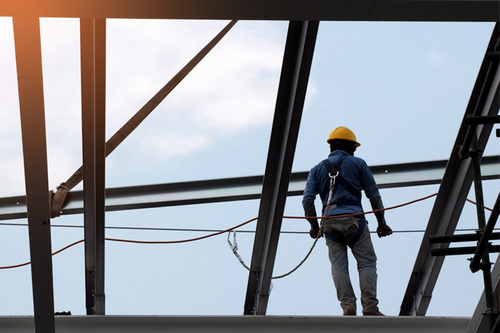How to Properly Fit and Adjust a Fall Arrest Harness
Wearing and adjusting a fall arrest harness is an important part of your job if you plan on working above ground level, such as on the side of a tower, ledge, or elevated platform. Everyone on your team should feel confident about putting on and adjusting their harness to prevent accidents and falls on the job. Knowing how to properly adjust a harness will also help your team stay comfortable, so they can do their jobs safely and efficiently.
Learn more about basic fall protection safety and how to properly attach and adjust a fall harness.
Finding the Right Fall Arrest Harness
The first step is to find a fall harness that suits the needs of you and your employees. Using poorly made or ergonomically incorrect equipment may leave your employees vulnerable on the job. They may have trouble adjusting their harness, which can lead to uncomfortable working conditions and potential safety hazards. The harness should be easy to use and fit comfortably over the body, so your employees can focus on the task at hand.
Wearing and Adjusting the Harness
- As a first step, grasp the harness by the back (dorsal) d-ring, and give it a good shake. Make sure that the straps are hanging straight, and that the harness is right side up.
- To start, put your arms through the shoulder loops and leg straps. Make sure both shoulder loops are vertical and spread out evenly across the chest.
- Attach the waist belt by inserting the male connector into the female connector. Do the same for each of the shoulder straps.
- All straps should be snug and pulled tight. Adjust the straps until the harness fits comfortably on the body. Make sure both leg straps have been secured properly.
- Once you’re wearing the harness and all buckles have been attached, stand up and try moving in any direction. The harness should feel centered and snug without limiting your range of motion.
- If there are any loose straps or buckles, use keepers or tie-down straps to keep them secure and out of the way, otherwise, these straps may get caught in moving parts or machinery.
You should never walk around with your buckles or straps undone. There’s always a chance you could forget to reattach your buckles or straps, leaving you vulnerable in the air. If you notice one of your colleagues walking around with their harness not fully attached, remind them to buckle up. Finally, attach your harness to your lanyard and an appropriate anchorage point. According to OSHA, all anchorage points must be able to support at least 5,000 pounds.
Petzl recently unveiled a new line of safety harnesses known as Volt. These harnesses are much lighter than most of the other harnesses on the market today. You can slide on this form-fitting harness like a jacket, helping your team get off the ground as fast as possible. Volt harnesses are known for their adjustable fit, giving you and your employees greater freedom of movement. The wide, semi-rigid belt provides added lumbar support for better positioning in the air.
It’s made with mesh for a lightweight, breathable fit that’s designed to keep you and your employees cool and comfortable. It also comes with shoulder loops that keep lanyard hooks out of the way, dorsal protections that limit wear when sliding against surfaces, and rear loops for organizing your tools. If your employees need to be suspended in the air for long periods of time, you can attach a seat to the harness, so your employees have a place to sit down.
Learn more about Petzl’s new safety harnesses, including the Petzl Volt LT Harness and Petzl Newton Easyfit International Harness, and see how they can benefit your business in more ways than one.
To improve fall safety, have your team practice putting on and adjusting their safety harnesses. If anyone has any questions or something doesn’t feel right, encourage them to speak up before sending them up in the air.
If you’re having trouble getting the proper fit on a harness, contact the professionals at PK Safety for more information. We’re here to make sure you and your team have everything you need to stay safe on the job.
Recent Posts
-
Customizing Gas Detectors: Tailoring Solutions to Fit Your Unique Requirements
In today’s diverse industrial landscape, a one-size-fits-all approach to safety simply doesn’t cu …Jul 3rd 2024 -
10 Ways to Prevent Wildfires
You can prevent wildfires by extinguishing flames before you leave the worksite. Avoid practicing …Jul 1st 2024 -
ANSI/ISEA 138 Safety Gloves: Ensuring Hand Protection
The human hand is an anatomical masterpiece and arguably the greatest tool attached to our bodies …Jun 25th 2024





